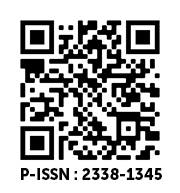Defatting and Fermentation Treatment on The Bioactive Compounds of Rice Bran
DOI:
https://doi.org/10.36782/apjsafe.v11i1.205Keywords:
antioxidant activity, bioactive components, fermentation, rice bran, total phenolic contentAbstract
Rice bran is a by-product of brown rice milling process. The aim of this study was to determine the effect of fermentation on the changes of total phenolic content, antioxidant activity, and bioactive components in rice bran with the combination of defatting treatment. Coloured rice bran (white, red, and black) was used in this study. Total phenolic content (TPC) and antioxidant activity were analysed with Folin-Ciocalteau and DPPH radical scavenging activity (RSA) method, respectively. Bioactive component of rice bran was analysed by HPLC. The highest TPC and RSA were shown on defatted and fermented white rice bran (288.18±2.52 mg GAE/100 g DB and 67.95±0.75%, respectively). The highest γ-oryzanol content and ferulic acid were shown in non-defatted fermented black rice bran and defatted fermented black rice bran with 24.83 mg/g and 1.45 mg/g sampel, respectively. The results of this study indicated that the fermentation treatment could increase the bioactive component of rice bran. Furthermore, combination of defatting and fermentation was only effective on white rice bran.
Downloads
References
Bhanja, T., Kumari, A., and Banerjee, R. 2009. Enrichment of phenolics and free radical scavenging property of wheat koji prepared with two filamentous fungi. Bioresource Technology, 100 (11): 2861–66.
Chotimarkorn, C. and Ushio H. 2008. The effect of trans-ferulic acid and gamma-oryzanol on ethanol-induced liver injury in C57BL mouse. Phytomedicine, 15 (11): 951–8.
Devi, R. R. and Arumughan, C. 2007. Phytochemical characterization of defatted rice bran and optimization of a process for their extraction and enrichment. Bioresource Technology, 98 (16): 3037–43.
Geetha, P. S, Maheswari, I., Anandham, R., and Nallakurumban, B. 2015. Heat stabilized defatted rice bran (HDRB) fermented with Saccharomyces cerevisiae var MTCC 3813 to enhance the protein content with bio activity. International Journal of Scientific and Research Publications, 5 (4): 1–7.
Gul, K., Yousuf, B., Singh, A.K., Singh, P., and Wani, A. A. 2015. Rice bran: Nutritional values and its emerging potential for development of functional food—A review. Bioactive Carbohydrates and Dietary Fibre, 6 (1): 24–30.
Iqbal, S., Bhanger, M.I., and Anwar, F. 2005. Antioxidant properties and components of some commercially available varieties of rice bran in Pakistan. Food Chemistry, 93 (2): 265–72.
Issara, U. and Rawdkuen, S. 2016. Rice bran: a potential of main ingredient in healthy beverage. International Food Research Journal. 23 (6): 2306–18.
Jieun, L., Eunjong, S., Dae-Hyuk, K., Kimoon, P., and Yong-Su, J. 2009. Fermentation of rice bran and defatted rice bran for butanol production using Clostridium beijerinckii NCIMB 8052. Journal of Microbiology and Biotechnology, 19 (5): 482–90.
Moongngarm, A., Daomukdaa, N., and Khumpika, S. 2012. Chemical compositions, phytochemicals, and antioxidant capacity of rice bran, rice bran layer, and rice germ. APCBEE Procedia, 2: 73–9.
Muntana, N and Prasong, S. 2010. Study on total phenolic contents and their antioxidant activities of Thai white, red, and black rice bran extracts. Pakistan Journal of Biological Science, 13 (4): 170–4.
Oliveira, M. S., Cipolatti, E. P., Furlong, E. B., and Soares, L. S. 2012. Phenolic compounds and antioxidant activity in fermented rice (Oryza sativa) bran. Ciência e Tecnologia de Alimentos. Campinas, 32 (3): 531–37.
Oliveira, M. S., Feddern, V., Kupski, L., Cipolatti, E. P., Furlong, E. B., and Soares, L. S. 2010. Physico-chemical characterization of fermented rice bran biomass. CyTA - Journal of Food, 8 (3): 229–36.
Patil, S. S., Kar, A., and Mohapatra, D. 2016. Stabilization of rice bran using microwave: Process optimization and storage studies. Food and Bioproducts Processing, 99: 209–211.
Pengkumsri, N., Chaiyavat, C., Chalermpong, S., Sasithorn, S., Sartjin, P., Prasit, S., Sophon, S., and Sundaram, S. B. 2015. Physicochemical and antioxidative properties of black, brown and red rice varieties of northern Thailand. Food Science and Technology, 35 (2): 331–38.
Rashid, N. Y. A., Razak, D. L. A., Jamaluddin, A., Sharifuddin, S. A., and Long, K. 2015. Bioactive compounds and antioxidant activity of rice bran fermented with lactic acid bacteria. Malaysian Journal of Microbiology, 11 (2): 156–62.
Razak, D. L. A., Rashid, N. Y. A., Jamaluddin, A., Sharifudin, S. A., and Long, K. 2015. Enhancement of phenolic acid content and antioxidant activity of rice bran fermented with Rhizopus oligosporus and Monascus purpureus. Biocatalysis and Agricultural Biotechnology, 4 (1): 33–8.
Sabir, A., Rafi, M., and Darusman, L. K. 2017. Discrimination of red and white rice bran from Indonesia using HPLC fingerprint analysis combined with chemometrics. Food Chemistry, 221: 1717–22.
Schmidt, C. G., Gonçalvesa, L. M., Priettoa, L., Hackbart, H. S., and Furlong, E. B. 2014. Antioxidant a 1 ctivity and enzyme inhibition of phenolic acids from fermented rice bran with fungus Rhizopus oryzae. Food Chemistry, 146: 371–77.
Silveira, C. M. and Furlong E. B. 2009. Sperathe effects of solid-state fermentation in the functional properties of defatted rice bran and wheat bran. Brazilian Archives of Biology and Technology, 52 (6): 1555–62.
Sirikul, A., Moongngarm, A., and Khaengkhan, P. 2009. Comparison of proximate composition, bioactive compounds and antioxidant activity of rice bran and defatted rice bran from organic rice and conventional rice. Asian Journal of Food and Agro-Industry. 2 (4): 731–43.
Suket, N., Srisook, E., dan Hrimpeng, K. 2014. Antimicrobial Activity of the Anthocyanins Isolated from Purple Field Corn (Zea mays L.) Cob against Candida spp. IOSR Journal of Pharmacy and Biological Sciences. 9 (4): 40–4.
Thitipramote, N., Pradmeeteekul, P., Nimkamnerd, J., Chaiwut, P., Pintathong, P., and Thitilerdecha, N. 2016. Bioactive compounds and antioxidant activities of red (Brown Red Jasmine) and black (Kam Leum Pua) native pigmented rice. International Food Research Journal, 23 (1): 410–14.
Wang, M., Hettiarachchy, N. S., Qi, M., Burks, W., and Siebenmorgen, T. 1999. Preparation and functional properties of rice bran protein isolate. Journal of Agriculture and Food Chemistry, 47 (2): 411–16.
Webber, D. M., Hettiarachchy, N. S., Ruiqi, L., Ronny, H., and Theivendran, S. 2014. Phenolic profile and antioxidant activity of extracts prepared from fermented heat-stabilized defatted rice bran. Journal of Food Science, 79 (11): 2383–91.









